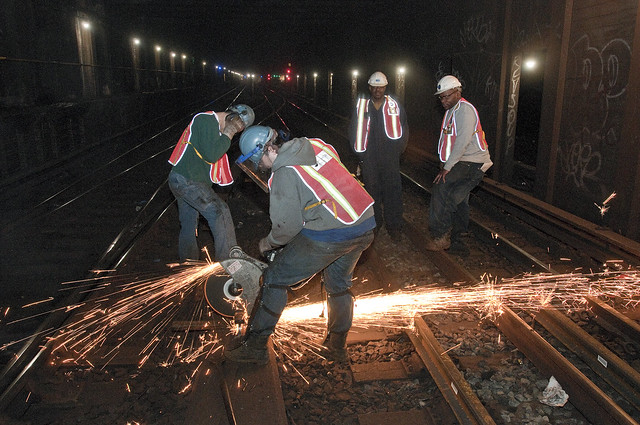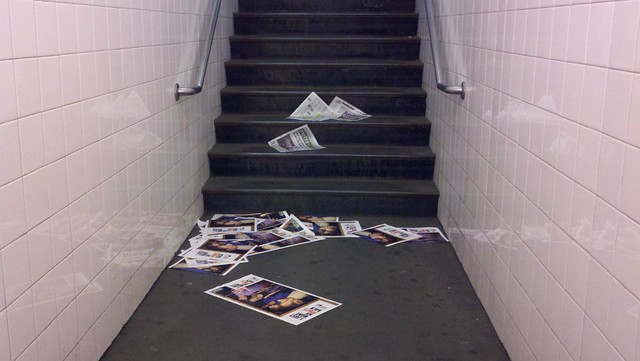Congestion pricing is one of those ideas that, rightfully so, just won’t fade away. While the official effort to bring a rational road usage and transportation funding plan to New York City died an ignoble death at the hands of Sheldon Silver a few years ago, urban advocates and transportation planners have kept the flame lit. This week, Bill Keller, current columnist for and former editor-in-chief of The New York Times, lent his voice to the discussion.
Keller’s column, billed as a profile of Sam Schwartz, begins with a discussion of New York’s “transportation hell.” The city’s central business district is on an island with a limited number of access points, and it relies on an aging and underfunded subway system to bring the vast majority of commuters to and from work each day. Over the past decade, through will power and billiongs, the MTA has been trying to expand its transportation network. The going is slow, though, and the funding is scarce.
It doesn’t have to be like that. While Governor Andrew Cuomo, an ambitious and powerful chief executive, hasn’t embraced transit, as Keller notes, smart minds have been working on a rational plan to control congestion, improve efficient and support transit. He writes:
Samuel I. Schwartz, a transportation engineer and New Yorker to his kishkes, has spent 40 years — half government, half private — trying to make sense of the M.T.A. He can tell you how it rewards congestion, keeps subways and buses in a state of decrepitude, and breeds resentment. He can regale you with incentives that are utterly perverse. (He prefers “cockamamie.”) One example: If you are a five-axle trucker bound for New Jersey, you can skirt Manhattan, take the highway over the Verrazano-Narrows and pay a $70 truck toll; or you can drag your belching bulk across the narrow streets of Chinatown, TriBeCa and Little Italy — toll-free. Guess what most truckers do.) Time and again Schwartz has labored over attempted reforms — remember “congestion pricing”? — only to see them shot down because they put all the pain on the outlying car-centric suburbs, or because they ran into an antitax mood, or because people suspected the money would be siphoned off for other purposes.
Over the years he has gradually constructed a plan that is a Brooklyn boy’s gift to his city. (Literally. No client paid for it.) It wipes clean the slate, replaces it with a system of tolls and fares designed as incentives to minimize congestion in the central business district, ease circulation around the region and revive public transit.
You do not have to be an engineer to appreciate the logic. The scheme puts the heaviest onus on the solo driver who has ready access to a train, and lowers the cost for drivers who have no alternative. Unlike earlier plans that amounted to a punishing tax on commuters from outlying communities, the Schwartz plan has more affluent neighborhoods (like the plusher parts of Manhattan, Brooklyn and Queens) pay a fair share. Though the main purpose is to underwrite public transport, the plan sets aside money to make the highways more bearable — in part so trucks will use them and avoid the populous business districts. Unlike plans that are all about cars and trains, Schwartz’s includes some lovely optional extras for the green at heart — graceful new bike-pedestrian bridges connecting the gentrified waterfront neighborhoods of Brooklyn, Queens and New Jersey to Manhattan.
As Keller notes, Schwartz’s plan could bring in $1.2 billion, reduce traffic and provide more jobs. It could allow for $15 billion in bonding for transit projects if the MTA wanted to go further into debt. Of course, as Transportation Nation noted, not everyone is lining up for this idea. “I don’t support tolling the East River Bridges,” Peter Vallone, a Queens representative, said. “There are ways to influence congestion without increasing costs to motorists.”
Yet, if the plan implemented is the right one — with dollars earmarked for the MTA and protected by an appropriate lockbox — the public has shown a willingness to embrace it. Is it a last gasp for the MTA or a plan to protect the city from crushing traffic? Perhaps it’s part of both, but whatever the full answer, it deserves another chance. Our city may just need it to grow for the next 100 years.



















 As the MTA has tried to become a leaner organization over the past few years, we’ve heard repeatedly about its attempts at slimming down its real estate portfolio. The MTA owns or leases a lot more space in this city that most people realize, and a good portion of that space is redundant or underused. So the authority has engaged in a process to identify what it can off-load and what it must keep.
As the MTA has tried to become a leaner organization over the past few years, we’ve heard repeatedly about its attempts at slimming down its real estate portfolio. The MTA owns or leases a lot more space in this city that most people realize, and a good portion of that space is redundant or underused. So the authority has engaged in a process to identify what it can off-load and what it must keep.